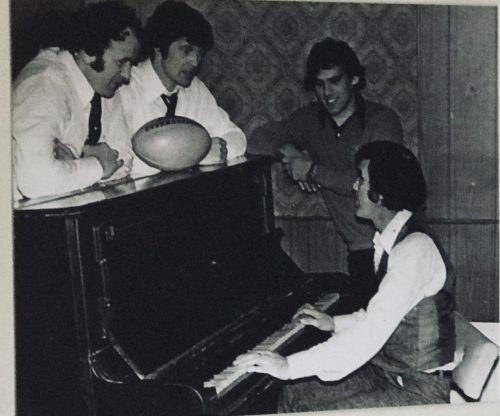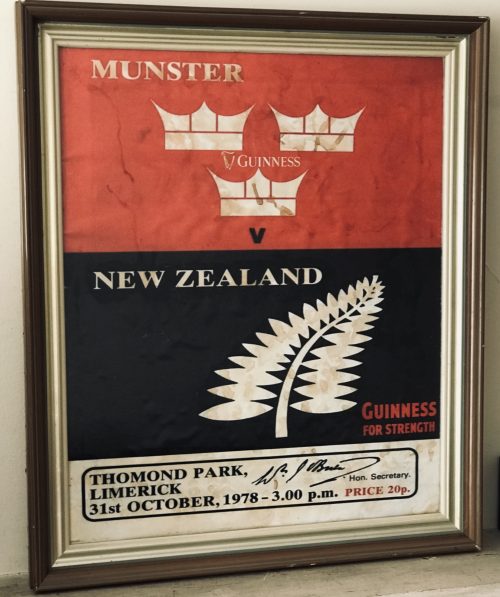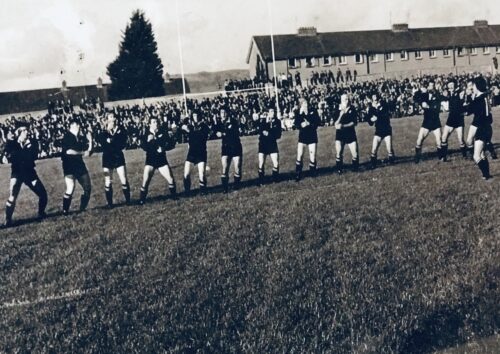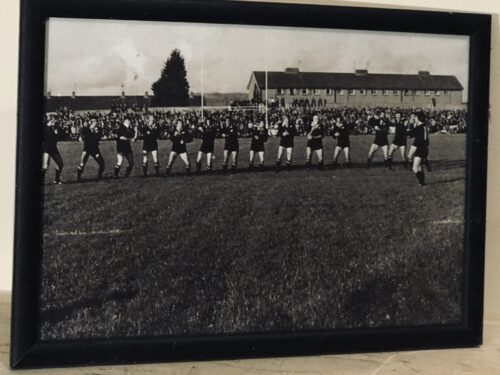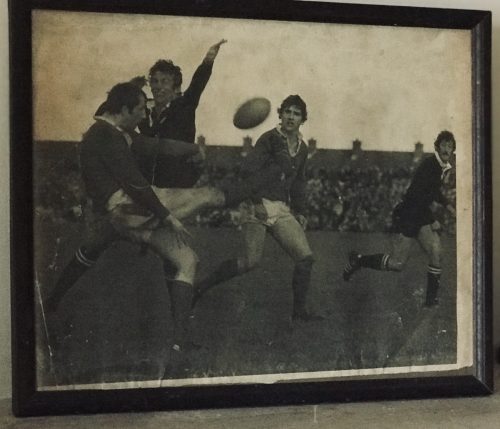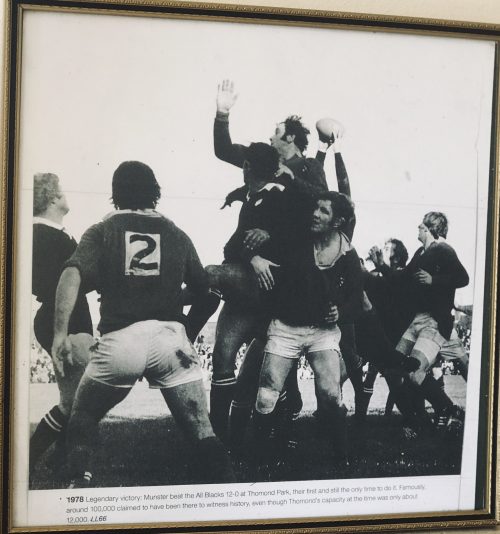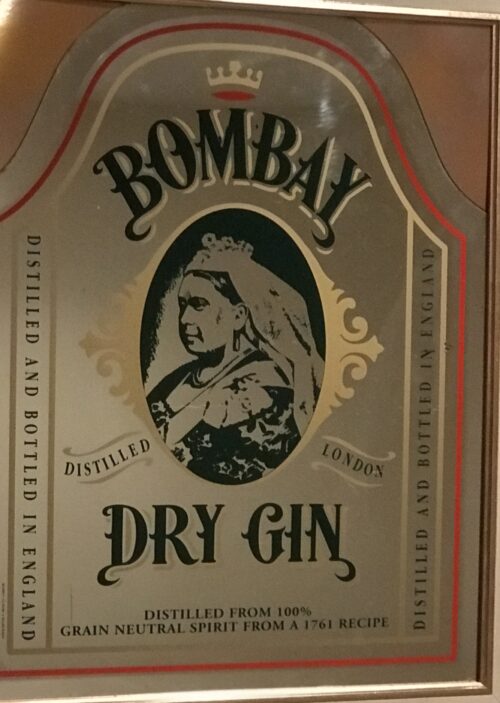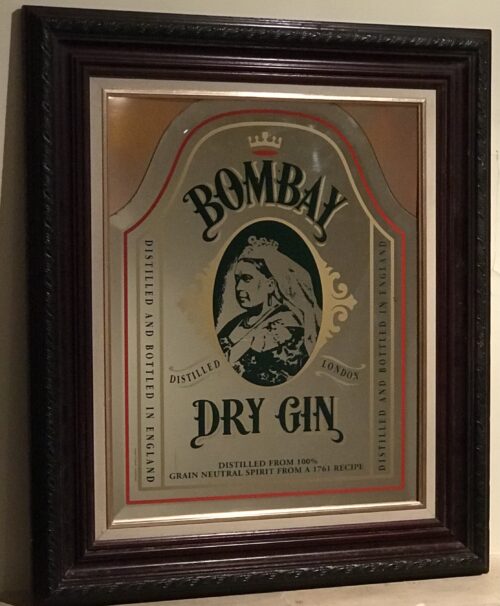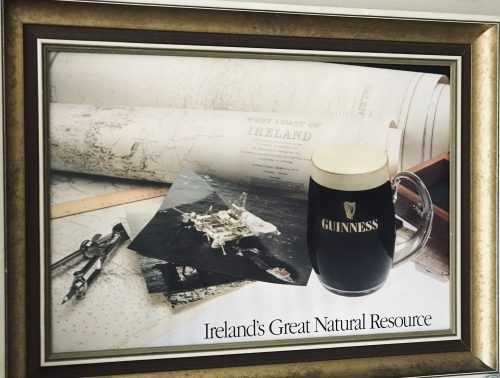Classy 1980s Bombay Dry Gin mirror in fantastic oak frame.Please contact us directly at irishpubemporium@gmail.com for pricing and shipment quotation.
Cork City. 72cm x 60cm
Bombay Sapphire is a brand of
gin that was first launched in 1986 by English
wine-merchant IDV. In 1997
Diageo sold the brand to
Bacardi.
Its name originates from the popularity of gin in
India during the
British Raj and "Sapphire" refers to the violet-blue
Star of Bombay which was mined from
Sri Lanka and is now on display at the
Smithsonian Institution.
Bombay Sapphire is marketed in a flat-sided, sapphire-coloured bottle that bears a picture of
Queen Victoria on the label.
The flavouring of the drink comes from a recipe of ten ingredients:
almond,
lemon peel,
liquorice,
juniper berries,
orris root,
angelica,
coriander,
cassia,
cubeb, and
grains of paradise. Alcohol brought in from another supplier is evaporated three times using a carterhead still, and the alcohol vapours are passed through a mesh/basket containing the ten botanicals, in order to gain flavour and aroma. This is felt to give the gin a lighter, more floral taste compared to those gins that are created using a copper
pot still. Water from
Lake Vyrnwy is added to bring the strength of Bombay Sapphire down to 40.0% (UK, the Nordics, several continental European markets, Canada and Australia).
The 47.0% version is the standard for sale at duty-free stores in all markets.
Production
In 2011, plans were announced to move the manufacturing process to a new facility at
Laverstoke Mill in
Whitchurch, Hampshire, including the restoration of the former
Portal's paper mill at the proposed site, and the construction of a visitor centre.
Planning permission was granted in February 2012, and the centre opened to the public in the autumn of 2014.
The visitor centre included a new construction by
Thomas Heatherwick of two glasshouses for plants used as botanicals in the production of Bombay Sapphire gin.
Production and bottling of the drink is contracted out by Bacardi to G&J Greenall.
Varieties
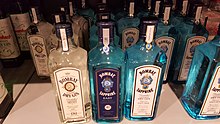
Three of the Bombay varieties
Bacardi also markets Bombay Original London Dry Gin (or Bombay Original Dry). Eight botanical ingredients are used in the production of the Original Dry variety, as opposed to the ten in Bombay Sapphire.
Wine Enthusiast preferred it to Bombay Sapphire.
In September 2011, Bombay Sapphire East was launched in test markets in
New York and
Las Vegas. This variety has another two botanicals, lemongrass and black peppercorns, in addition to the original ten. It is bottled at 42% and was designed to counteract the sweetness of American
tonic water.
A special edition of Bombay gin called Star of Bombay was produced in 2015 for the UK market. It is bottled at 47.5% and is distilled from grain. It features bergamot and ambrette seeds in harmony with Bombay's signature botanicals. This version has later been extended to several other markets.
Another variety is Bombay Bramble, it’s Infused with fresh Black- and Raspberries and bottled at 37.5% ABV.
In summer 2019, Bacardi launched a limited edition gin called Bombay Sapphire English Estate, which features three additional English sourced botanicals: Pennyroyal Mint, rosehip and hazelnut. It is bottled at 41%.
Design connection
The brand started a series of
design collaborations. Their first step into the design world was a series of advertisements featuring work from currently popular designers. Their works, varying from
martini glasses to tiles and cloth patterns, are labelled as “Inspired by Bombay Sapphire”. The campaign featured designers such as
Marcel Wanders,
Yves Behar,
Karim Rashid,
Ulla Darni, and
Dror Benshetrit and performance artist Jurgen Hahn.
From the success of this campaign, the company began a series of events and sponsored locations. The best known is the Bombay Sapphire Designer Glass Competition, held each year, where design students from all over the world can participate by designing their own “inspired” martini cocktail glass. The finalists (one from each participating country) are then invited to the yearly Salone del Mobile, an international design fair in Milano, where the winner is chosen.
Bombay Sapphire also endorses glass artists and designers with the Bombay Sapphire Prize, which is awarded every year to an outstanding design which features glass. Bombay Sapphire also showcases the designers' work in the Bombay Sapphire endorsed blue room, which is a design exhibition touring the world each year.
From 2008 the Bombay Sapphire Designer Glass Competition final will be held at 100% Design in London, UK and the Bombay Sapphire Prize will take place in Milan at the Salone Del Mobile.
Evaluation
Bombay Sapphire has been reviewed by several outside
spirit ratings organizations to various degrees of success. Recently, it was awarded a score of 92 (on a 100-point scale) from the
Beverage Testing Institute. Ratings aggregator Proof66.com categorizes the Sapphire as a Tier 2 spirit, indicating highly favourable "expert" reviews.
Cultural references
|
Bombay Sapphire was used in the video work Victoria Day (Bombay Sapphire), 2002 by contemporary artists Marina Roy and Abbas Akhavan. |
- Long time sports radio personality Jim Rome is known for his love of Bombay Sapphire Gin, which he often refers to as "the Magic Blue".
- American hip-hop artist Wiz Khalifa and his "Taylor Gang" are also known for their love of Bombay Sapphire dry gin.
- Former Las Vegas, Nevada mayor Oscar Goodman is known for his love of Bombay Sapphire Gin, and he has served as a spokesman for the brand.
- American musician Robert Earl Keen references "a quart of Bombay gin" in the song "The Road Goes on Forever".
- American YouTuber/streamer Etika was known for drinking Bombay Sapphire, among other alcoholic drinks, during streams as a way to celebrate donations.
- In the Netflix series Bojack Horseman a bottle strongly resembling Bombay Sapphire can be seen in Princess Carolyn's office.
Gorgeous Gordon's -This is the Gin tin advertising sign.As the
Fantastic,rare antique tin Gordon's Gin Advertising sign from the 1940's.-manufactured by Sir Joseph Causton & Sons Ltd London (more information at bottom).At the top of the sign is the Royal Crest and By appointment Gin Distiller To H.M King George VI.
Gordon's is a brand of London dry
gin first produced in 1769. The top markets for Gordon's are (in descending order) the United Kingdom, the United States and Greece.
It is owned by the British spirits company
Diageo and, in the UK, is made at
Cameron Bridge Distillery in
Fife, Scotland (although flavourings may be added elsewhere).It is the world's best-selling London dry gin.
Gordon's has been the UK's number one gin since the late 19th century.
A 40%
ABV version for the North American market is distilled in Canada.
Gordon's London Dry Gin was developed by Alexander Gordon, a Londoner of Scots descent.
He opened a distillery in the Southwark area in 1769, later moving in 1786 to
Clerkenwell.
The
Special London Dry Gin he developed proved successful, and its recipe remains unchanged to this day.
Its popularity with the
Royal Navy saw bottles of the product distributed all over the world.
In 1898 Gordon & Co. amalgamated with
Charles Tanqueray & Co. to form Tanqueray Gordon & Co. All production moved to the Gordon's
Goswell Roadsite. In 1899,
Charles Gordon died, ending the family association with the business.
In 1904 the distinctive square-faced, green bottle for the home market was introduced. In 1906 Gordon's Sloe Gin went into production. The earliest evidence in recipe books for the production of Gordon's Special Old Tom was in 1921.
In 1922 Tanqueray Gordon & Co. was acquired by the
Distillers Company. In 1924 Gordon's began production of a 'Ready-to-Serve' Shaker Cocktail range, each in an individual shaker bottle.
In 1925 Gordon's was awarded its first
Royal Warrant by
King George V.
In 1929 Gordon's released an orange gin followed by a lemon variety in 1931.
In 1934 Gordon's opened its first distillery in the US, at
Linden, New Jersey.
By 1962 at least it was the world's highest selling gin.
In 1984 British production was moved to
Laindon in Essex. In 1998 production was moved to Fife in Scotland, where it remains to this day.
Every label and bottle top of Gordon's gin bears a depiction of a
wild boar. According to legend a member of
Clan Gordon saved the
King of Scotland from the animal while hunting.
Products

An export bottle of Gordon's London Dry Gin
According to the manufacturer, Gordon's gin is triple-distilled and contains juniper berries, coriander seeds, angelica root, licorice, orris root, orange, and lemon peel, though the exact recipe has remained a closely guarded secret since 1769. It differed from others at the time in that it didn't add sugar, which made it a "dry" gin.
It takes ten days' distillation after receiving the wheat to create a finished product of a bottle of Gordon's Gin.
In the UK Gordon's is sold in a green glass bottle, but in export markets, it is sold in a clear bottle.
Some airport duty-free shops sell it in plastic bottles in the 75cl size.
Gordon's is sold in several different strengths depending on the market. In the US, the strength is 40% ABV. Until 1992, the ABV in the UK was 40%, but it was reduced to 37.5% to bring Gordon's gin into line with other white spirits such as white rum and vodka, and also reduce production costs
(the other leading brands of gin in the UK,
Beefeater gin and
Bombay Sapphire, are both 40% ABV in the UK). In continental Europe and in some duty-free stores, a 47.3% ABV version (Traveller's Edition) is available in addition to the 37.5% one, while in New Zealand and Australia, as of 2011, it is sold at 37.2% ABV,
and in South Africa, it is 43% ABV.
In addition to the main product line, Gordon's also produces a
sloe gin; a vodka (US & Venezuela only), two
alcopop variants, Space and Spark; three vodka liqueur variants, Cranberry, Parchita and Limon (Venezuela only) and a canned, pre-mixed gin and tonic as well as a canned Gordon's and Grapefruit (500ml - Russia only).
On 11 February 2013, Gordon's announced the release of Gordon's Crisp Cucumber, a flavored gin, which blends the original gin with
cucumber flavor.
In early 2014, Gordon's Elderflower was added to their "flavored" gin collection, and is made in much the same way, with a natural
elderflower flavoring being added to the original recipe.
In August 2017, Gordon's began selling Gordons Pink, a pink-colored gin flavored with several types of red berries.
In February 2020, Gordon’s launched two new flavours in lemon and peach.
In April 2020, it was announced that Gordon’s were launching an orange flavoured gin.
Discontinued products
Gins
- Gordon's special Old Tom Gin (1921–1987)
- Orange Gin (1929–1988, 2020–)
- Lemon Gin (1931–1988, 2020–)
- Spearmint gin (US only)
- Gordon's Distiller's Cut - A luxury version of the gin, released in 2004, with additional botanicals of lemongrass and ginger.
Shaker cocktails
A range of pre-mixed drinks:
- (1924–1967) Fifty-Fifty, Martini, Dry Martini, Perfect, Piccadilly, followed by Manhattan, San Martin, Dry San Martin and Bronx.
- (1930–1967) Rose, Paradise and Gimlet 1930-1967.
- (1924–1990) Dry/Extra Dry Martini
Other products
- Finest Old Jamaica Rum
- Orange Bitters (made from Seville Oranges)
In popular culture

1912 bottle of Gordon’s Gin
Gordon's Gin is specified by name in the recipe for the
Vesper Cocktail given by
James Bond in
Ian Fleming's 1953 novel
Casino Royale.
Gordon's was
Ernest Hemingway's favourite gin, which he claimed could "fortify, mollify and cauterize practically all internal and external injuries".
In the movie
The African Queen Katharine Hepburn's character pours
Humphrey Bogart's entire crate of Gordon's bottles into the river and floats away from the empties.
In the 14th episode of the anime series
Transformers: Super God Masterforce, towards the end of the episode, a hospital patient reveals that he snuck in a bottle of Gordon's Gin and the label was in its export colors.
In the film
The Sting,
Paul Newman's character drinks Gordon’s Gin whilst playing cards with
Robert Shaw's character.
In the film
The Big Heat,
Gloria Grahame's character mixes a cocktail with Gordon's Gin.
According to an eyewitness account cited in
A Night to Remember (book) by
Walter Lord, a passenger of the
RMS Titanic "drained" a bottle of Gordon's Gin and survived the sinking.
n 1863, Joseph Causton and his son, also named Joseph, developed the printing company which was to become the large and well known Joseph Causton & Sons Limited.
In 1867 the company was described as being a wholesale stationer and printer with a large warehouse at Southwark Street, London.
Joseph Causton was also a politician. He became a Councillor for Billingsgate, East London in 1868 and later Sheriff for London and Middlesex. The pinnacle of his career came when Queen Victoria opened Blackfriars Bridge and Holburn Viaduct in 1869 and he was knighted at Windsor Castle to mark the event. The company name now became Sir Joseph Causton & Sons Limited. Sir Joseph died just two years later but his sons, Joseph, Richard and James continued as partners of the firm.
The company moved to a large new printing works in Eastleigh, Hampshire in the 1930s. The printing works made labels for household brands including Marmite and Guiness. During The Second World War they printed secret maps for the government in a specially bricked off part of the building.
By the end of the 1960s Sir Joseph Causton & Sons Limited fortunes were in decline. In the mid 1970s the company was losing money but it was not until 1984 that the firm was taken over by Norton Opex. They in turn were acquired by Bowater and Sir Joseph Causton and Sons ceased trading.
The Causton name has survived only as Causton Envelopes Limited and Causton Cartons, which is a subsidiary of the Bowater Group, manufacturing cartons for the pharmaceutical industry.
 Tom Moloughney, Jimmy Doyle, and Kieran Carey relax in the dressing room after Tipperary’s victory over Dublin in the 1961 All-Ireland final, a success that was to be repeated the following year. Picture from ‘The GAA — A People’s History’
Tom Moloughney, Jimmy Doyle, and Kieran Carey relax in the dressing room after Tipperary’s victory over Dublin in the 1961 All-Ireland final, a success that was to be repeated the following year. Picture from ‘The GAA — A People’s History’











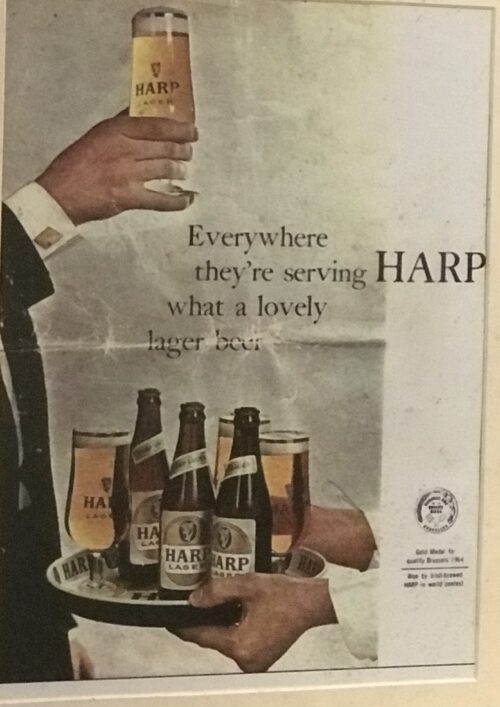
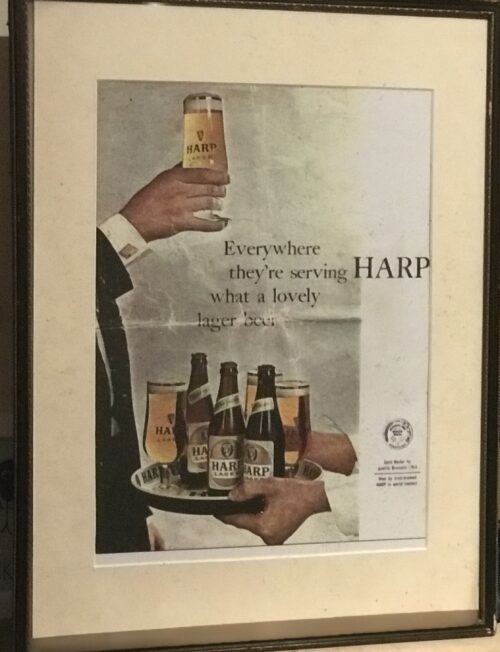









 Cork’s Ray Cummins (right) flicking the ball past Clare fullback Jim Power. Cummins goal in the 1977 Munster final turned the match around.
Cork’s Ray Cummins (right) flicking the ball past Clare fullback Jim Power. Cummins goal in the 1977 Munster final turned the match around.



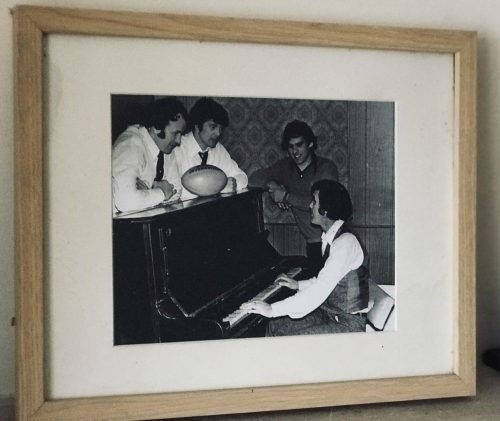

 Many years on, Stuart Wilson vividly recalled the Dennison tackles and spoke about them in remarkable detail and with commendable honesty: “The move involved me coming in from the blind side wing and it had been working very well on tour. It was a workable move and it was paying off so we just kept rolling it out. Against Munster, the gap opened up brilliantly as it was supposed to except that there was this little guy called Seamus Dennison sitting there in front of me.
“He just basically smacked the living daylights out of me. I dusted myself off and thought, I don’t want to have to do that again. Ten minutes later, we called the same move again thinking we’d change it slightly but, no, it didn’t work and I got hammered again.”
The game was 11 minutes old when the most famous try in the history of Munster rugby was scored.
Tom Kiernan recalled: “It came from a great piece of anticipation by Bowen who in the first place had to run around his man to get to Ward’s kick ahead. He then beat two men and when finally tackled, managed to keep his balance and deliver the ball to Cantillon who went on to score. All of this was evidence of sharpness on Bowen’s part.”
Very soon it would be 9-0. In the first five minutes, a towering garryowen by skipper Canniffe had exposed the vulnerability of the New Zealand rearguard under the high ball. They were to be examined once or twice more but it was from a long range but badly struck penalty attempt by Ward that full-back Brian McKechnie knocked on some 15 yards from his line and close to where Cantillon had touched down a few minutes earlier. You could sense White, Whelan, McLoughlin and co in the front five of the Munster scrum smacking their lips as they settled for the scrum. A quick, straight put-in by Canniffe, a well controlled heel, a smart pass by the scrum-half to Ward and the inevitability of a drop goal. And that’s exactly what happened.
The All Blacks enjoyed the majority of forward possession but the harder they tried, the more they fell into the trap set by the wily Kiernan and so brilliantly carried out by every member of the Munster team.
The tourists might have edged the line-out contest through Andy Haden and Frank Oliver but scrum-half Mark Donaldson endured a miserable afternoon as the Munster forwards poured through and buried him in the Thomond Park turf.
As the minutes passed and the All Blacks became more and more unsure as to what to try next, the Thomond Park hordes chanted “Munster-Munster–Munster” to an ever increasing crescendo until with 12 minutes to go, the noise levels reached deafening proportions.
And then ... a deep, probing kick by Ward put Wilson under further pressure. Eventually, he stumbled over the ball as it crossed the line and nervously conceded a five-metre scrum. The Munster heel was disrupted but the ruck was won, Tucker gained possession and slipped a lovely little pass to Ward whose gifted feet and speed of thought enabled him in a twinkle to drop a goal although surrounded by a swarm of black jerseys. So the game entered its final 10 minutes with the All Blacks needing three scores to win and, of course, that was never going to happen.
Munster knew this, so, too, did the All Blacks. Stu Wilson admitted as much as he explained his part in Wardy’s second drop goal: “Tony Ward banged it down, it bounced a little bit, jigged here, jigged there, and I stumbled, fell over, and all of a sudden the heat was on me. They were good chasers. A kick is a kick — but if you have lots of good chasers on it, they make bad kicks look good. I looked up and realised — I’m not going to run out of here so I just dotted it down. I wasn’t going to run that ball back out at them because five of those mad guys were coming down the track at me and I’m thinking, I’m being hit by these guys all day and I’m looking after my body, thank you. Of course it was a five-yard scrum and Ward banged over another drop goal. That was it, there was the game”.
The final whistle duly sounded with Munster 12 points ahead but the heroes of the hour still had to get off the field and reach the safety of the dressing room. Bodies were embraced, faces were kissed, backs were pummelled, you name it, the gauntlet had to be walked. Even the All Blacks seemed impressed with the sense of joy being released all about them. Andy Haden recalled “the sea of red supporters all over the pitch after the game, you could hardly get off for the wave of celebration that was going on. The whole of Thomond Park glowed in the warmth that someone had put one over on the Blacks.”
Controversially, the All Blacks coach, Jack Gleeson (usually a man capable of accepting the good with the bad and who passed away of cancer within 12 months of the tour), in an unguarded (although possibly misunderstood) moment on the following day, let slip his innermost thoughts on the game.
“We were up against a team of kamikaze tacklers,” he lamented. “We set out on this tour to play 15-man rugby but if teams were to adopt the Munster approach and do all they could to stop the All Blacks from playing an attacking game, then the tour and the game would suffer.”
It was interpreted by the majority of observers as a rare piece of sour grapes from a group who had accepted the defeat in good spirit and it certainly did nothing to diminish Munster respect for the All Blacks and their proud rugby tradition.
Many years on, Stuart Wilson vividly recalled the Dennison tackles and spoke about them in remarkable detail and with commendable honesty: “The move involved me coming in from the blind side wing and it had been working very well on tour. It was a workable move and it was paying off so we just kept rolling it out. Against Munster, the gap opened up brilliantly as it was supposed to except that there was this little guy called Seamus Dennison sitting there in front of me.
“He just basically smacked the living daylights out of me. I dusted myself off and thought, I don’t want to have to do that again. Ten minutes later, we called the same move again thinking we’d change it slightly but, no, it didn’t work and I got hammered again.”
The game was 11 minutes old when the most famous try in the history of Munster rugby was scored.
Tom Kiernan recalled: “It came from a great piece of anticipation by Bowen who in the first place had to run around his man to get to Ward’s kick ahead. He then beat two men and when finally tackled, managed to keep his balance and deliver the ball to Cantillon who went on to score. All of this was evidence of sharpness on Bowen’s part.”
Very soon it would be 9-0. In the first five minutes, a towering garryowen by skipper Canniffe had exposed the vulnerability of the New Zealand rearguard under the high ball. They were to be examined once or twice more but it was from a long range but badly struck penalty attempt by Ward that full-back Brian McKechnie knocked on some 15 yards from his line and close to where Cantillon had touched down a few minutes earlier. You could sense White, Whelan, McLoughlin and co in the front five of the Munster scrum smacking their lips as they settled for the scrum. A quick, straight put-in by Canniffe, a well controlled heel, a smart pass by the scrum-half to Ward and the inevitability of a drop goal. And that’s exactly what happened.
The All Blacks enjoyed the majority of forward possession but the harder they tried, the more they fell into the trap set by the wily Kiernan and so brilliantly carried out by every member of the Munster team.
The tourists might have edged the line-out contest through Andy Haden and Frank Oliver but scrum-half Mark Donaldson endured a miserable afternoon as the Munster forwards poured through and buried him in the Thomond Park turf.
As the minutes passed and the All Blacks became more and more unsure as to what to try next, the Thomond Park hordes chanted “Munster-Munster–Munster” to an ever increasing crescendo until with 12 minutes to go, the noise levels reached deafening proportions.
And then ... a deep, probing kick by Ward put Wilson under further pressure. Eventually, he stumbled over the ball as it crossed the line and nervously conceded a five-metre scrum. The Munster heel was disrupted but the ruck was won, Tucker gained possession and slipped a lovely little pass to Ward whose gifted feet and speed of thought enabled him in a twinkle to drop a goal although surrounded by a swarm of black jerseys. So the game entered its final 10 minutes with the All Blacks needing three scores to win and, of course, that was never going to happen.
Munster knew this, so, too, did the All Blacks. Stu Wilson admitted as much as he explained his part in Wardy’s second drop goal: “Tony Ward banged it down, it bounced a little bit, jigged here, jigged there, and I stumbled, fell over, and all of a sudden the heat was on me. They were good chasers. A kick is a kick — but if you have lots of good chasers on it, they make bad kicks look good. I looked up and realised — I’m not going to run out of here so I just dotted it down. I wasn’t going to run that ball back out at them because five of those mad guys were coming down the track at me and I’m thinking, I’m being hit by these guys all day and I’m looking after my body, thank you. Of course it was a five-yard scrum and Ward banged over another drop goal. That was it, there was the game”.
The final whistle duly sounded with Munster 12 points ahead but the heroes of the hour still had to get off the field and reach the safety of the dressing room. Bodies were embraced, faces were kissed, backs were pummelled, you name it, the gauntlet had to be walked. Even the All Blacks seemed impressed with the sense of joy being released all about them. Andy Haden recalled “the sea of red supporters all over the pitch after the game, you could hardly get off for the wave of celebration that was going on. The whole of Thomond Park glowed in the warmth that someone had put one over on the Blacks.”
Controversially, the All Blacks coach, Jack Gleeson (usually a man capable of accepting the good with the bad and who passed away of cancer within 12 months of the tour), in an unguarded (although possibly misunderstood) moment on the following day, let slip his innermost thoughts on the game.
“We were up against a team of kamikaze tacklers,” he lamented. “We set out on this tour to play 15-man rugby but if teams were to adopt the Munster approach and do all they could to stop the All Blacks from playing an attacking game, then the tour and the game would suffer.”
It was interpreted by the majority of observers as a rare piece of sour grapes from a group who had accepted the defeat in good spirit and it certainly did nothing to diminish Munster respect for the All Blacks and their proud rugby tradition.
